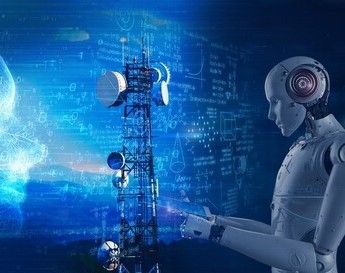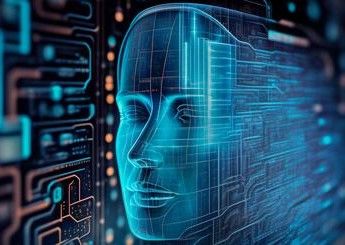AI Robotics Evolution: Exploring the impact, opportunities and challenges
)
With companies like T-Mobile leveraging AI-driven systems for automation, Coinbase exploring AI for fraud detection and operational efficiency, and Boston Dynamics revolutionizing robotic movement, the synergy between AI and robotics is propelling innovation across sectors. Yet the field of AI and robotics goes beyond innovation, with a need for deep collaboration and partnerships to look at responsible and ethical approaches to technology.
With rapid developments in this sector there also comes a set of unique challenges and exciting opportunities, shaping what the future of AI robotics will look like. For example, how robots are tackling tasks that humans can’t, and what this means, balancing legislation with innovation and implications this brings for society. In this article, we will dive into the current landscape, highlight key innovations, and explore what the future holds for AI-driven robotics.

The AI Summit New York team spoke to Lynn Wu, Associate Professor of Operations, Information and Decisions - Wharton School of the University of Pennsylvania, who is joining the panel session ‘Next AI Frontier – Robots, Brain Chips, AGI’ at The AI Summit New York, Dec 12.
Lynn shares her insight into significant challenges facing AI and Robotics, opportunities in play and some of the exciting innovations she sees on the horizon for the next 12 months.
Secure your seat at the panel session
Key Challenges in AI and Robotics Today
As groundbreaking as AI and robotics are, the field faces significant challenges in terms of scalability, deployment, and human-robot collaboration.
Scalability and Real-World Deployment
Robots, unlike purely digital AI systems, must navigate complex, physical environments. This makes real-world deployment particularly challenging. AI-driven robots require a continuous stream of real-world data to improve their functionality, but obtaining this data remains difficult. Unlike AI, which benefits from digital data generated by human activities online, robotics lacks a similar, accessible reservoir of information. Additionally, the cost and effort involved in real-world deployment are prohibitive for many companies.
The most pressing challenge in robotic advancement is the lack of real-world data. Unlike AI systems that can leverage vast amounts of digital data, robots require data generated from physical interactions with humans and their environment. This type of data is particularly difficult to obtain, which fundamentally limits the progress robots can make. AI has seen rapid advancement partly due to the availability of digital traces from human interactions online, but we have yet to develop an equivalent data source for robots.

While synthetic data has been explored as a potential solution, research indicates that there are inherent limitations when using it for training robots. Although it can supplement real-world data, it cannot fully replicate the complexity and unpredictability of real-world environments.
|
"The rise of automated reality and virtual reality (AR/VR) technology presents a potential avenue for addressing this data shortage, as these platforms can capture and simulate human interactions in controlled environments. But it remains to be seen how effectively AR/VR can mitigate data acquisition problems in robotics, and to what extent it can substitute real-world experiences for training purposes." Lynn Wu, Associate Professor of Operations, Information and Decisions - Wharton School of the University of Pennsylvania |
While technologies like Augmented Reality (AR) and Virtual Reality (VR) offer hope for generating synthetic data that simulates human-robot interaction, these systems still fall short of mimicking the unpredictable nature of real-world environments.
Human-Robot Collaboration
Another critical challenge is creating robots that can work seamlessly with humans. Collaborative robots, or cobots, are gaining traction, but ensuring smooth human-robot interaction without compromising safety or efficiency is still a major hurdle. Enhancing these collaborations is key to realizing the full potential of robotics in dynamic environments, such as hospitals, where robots need to assist humans in real-time without disruptions.
Anticipating the Evolution of These Challenges
Looking ahead, as AI models continue to evolve, the integration of large language models (LLMs) could enable robots to better understand and react to human language, thereby easing human-robot collaboration and real-world deployment.
|
"Collaborative robots, or "cobots”, are poised to become one of the most promising opportunities in AI-driven robotics over the next year. While fully autonomous robots remain a long-term goal for most industries, cobots will continue to gain traction as they work alongside humans, combining the strengths of both. I especially see areas for growth in healthcare and service operations. In these sectors, cobots are likely to enhance productivity, improve safety, and fill in labor gaps. While robots still face limitations in handling unpredictable environments or tasks requiring fine motor skills, the next year will see continued incremental improvements, especially in human-robot collaboration. In healthcare, cobots will play an increasingly important role in assisting surgeons with precision tasks, offering enhanced control and reducing human error in complex procedures. In settings like eldercare or hospitals, cobots will help lift and transfer patients, reducing the physical strain on caregivers while improving patient safety. Robots are likely to handle tasks such as delivering medications to patients in hospitals, streamlining logistics and allowing healthcare workers to focus on more critical tasks. Cobots come particularly handy for their ability to automate routine tasks, a boon in service environments such as restaurants, hotels, and retail. In these sectors, cobots will continue to handle tasks like cleaning, food preparation, and delivery. Humans will still manage more complex interactions, while robots assist with routine, repetitive functions." Lynn Wu, Associate Professor of Operations, Information and Decisions - Wharton School of the University of Pennsylvania |
Promising Opportunities in AI-Driven Robotics
Amidst the challenges, the opportunities within AI robotics are immense. The integration of AI offers numerous potential breakthroughs across industries, with some sectors already experiencing substantial growth.
Sectors Poised for Growth
Cobots, robots designed to collaborate with humans, are set to become a dominant force in sectors like healthcare, logistics, and service industries.
In healthcare, cobots assist surgeons with precision tasks, thereby reducing the risk of human error in complex procedures. These robots are also being used in eldercare, helping caregivers transfer patients safely, or even in routine tasks like medication delivery in hospitals.
Service sectors like hospitality and retail are also seeing increased automation through cobots, where they handle repetitive tasks such as cleaning, food preparation, and delivery.

Emerging Applications
Another promising area is the application of AI robotics in supply chains. Automated warehouse management systems and delivery robots are poised to optimize logistics in industries as varied as e-commerce and manufacturing.
Recent Innovations in AI Robotics
Several cutting-edge innovations are addressing these challenges and opening new avenues for exploration.
|
Merging large language models (LLMs) with robotics is a transformative innovation that can significantly enhance robot-human interaction and expand the adoption of robots in various industries in notable ways:
|
The Role of Regulation in AI-Driven Robotics
The rapid advancement of AI-driven robotics brings regulatory challenges that must be addressed to ensure safe and ethical deployment.
The Importance of Regulatory Frameworks
Given the physical interaction of robots with human environments, regulation is crucial. AI systems operating in the digital realm face fewer risks than robots navigating the physical world.
|
Safety is crucial when deploying robotics technology, especially because physical robots interact directly with the same environments humans inhabit. Therefore, it is even more critical to ensure the safety of physical robots compared to AI systems that primarily operate in the digital realm. Regulatory frameworks play a vital role in ensuring the safe, ethical, and responsible use of these technologies. The other key areas in the regulatory framework that should be considered:
|
Recent Innovations in AI and Robotics: Transforming Industries and Creating New Opportunities
One of the most exciting recent innovations in AI and robotics is the integration of large language models (LLMs) with robotics, enabling robots to understand and respond to natural language. This makes them easier to operate and more adaptable across sectors like healthcare and manufacturing. Another breakthrough is in soft robotics, which utilizes flexible materials to perform delicate tasks. These robots are revolutionizing healthcare through non-invasive surgeries and rehabilitation, as well as agriculture by gently harvesting crops. Both innovations are opening up new applications in traditional industries and creating opportunities in emerging sectors such as logistics, eldercare, and service operations.
|
I find the advancements in soft robotics particularly exciting. These robots, made from flexible and deformable materials, are designed to interact more gently with humans and delicate objects. AI algorithms are significantly improving their adaptability and movement, enabling soft robots to perform complex tasks that require precision and care. In healthcare, for instance, soft robots are being used in non-invasive surgeries and rehabilitation therapy, offering more refined and gentle interactions that improve patient outcomes. In industries like agriculture and food handling, soft robots are revolutionizing the way delicate crops — such as fruits and vegetables — are harvested, where traditional robots would likely cause damage due to their rigidity.
|
Governance, Policy, and AI Robotics
Governments worldwide are grappling with how to regulate the rapid advancement of AI and robotics.

Recent Developments in AI and Robotics Policy
Recent policies, such as the U.S. CHIPS Act, aim to democratize access to AI technologies by encouraging domestic semiconductor production. This initiative ensures that companies can access the foundational technologies required for AI innovation, preventing monopolies from stifling progress.
Governments’ Role in Regulating AI-Driven Robotics
International regulatory bodies are working on frameworks that balance fostering innovation with ethical responsibility. Central to these efforts is the need to ensure that AI and robotics technologies remain accessible to smaller organizations while maintaining strict safety and ethical standards.
|
One of the key aspects of AI robotics policy is addressing competition. There is an increasing concentration of power in every layer of the AI ecosystem, particularly in the compute layer, which includes chips, cloud infrastructure, and foundational models. Currently, only a handful of major players dominate these critical areas, and any generative AI applications rely heavily on access to these layers. While we are seeing a thriving ecosystem of AI applications, this innovation is ultimately limited by the bottlenecks in the underlying infrastructure. Moore’s Law, which predicts the exponential growth of computing power, may not help as much as we hope in this scenario. Even as compute power advances, the concentration of control over these resources means that prices may not decrease as quickly, limiting accessibility. Fostering the growth of AI and robotic systems requires democratizing access to these foundational layers. This means ensuring that AI is accessible to a wider range of organizations and individuals, not just a few wealthy firms. Initiatives like the U.S. CHIPS Act are important steps in this direction, as they aim to restore some competitiveness in the semiconductor space and reduce reliance on a small number of global suppliers, ultimately making AI innovation more accessible. |
Balancing Innovation and Ethics in AI Robotics
The delicate balance between innovation and ethics is central to the continued evolution of AI-driven robotics.
Managing the Ethical Implications of AI Advancements
As AI becomes more sophisticated, ensuring its ethical application is critical. AI systems, especially in robotics, must be designed with considerations for privacy, accountability, and security. Policymakers and industry leaders must collaborate to create ethical guidelines that allow innovation to flourish while protecting individuals and society at large.
Role of Governance, Policy, and Industry Standards
Effective governance and industry standards are crucial in guiding the responsible development of AI-driven robotics. While regulations must ensure safety, they should not impede innovation, particularly in nascent fields where the full potential of AI robotics has yet to be realized.
| It’s incredibly important for organizations and regulators alike to monitor the robotics field closely to maintain safety, ethics, accountability, and data security. But regulation must be practiced judiciously to avoid stifling innovation, particularly since many areas in robotics and the future of the field remains unclear. This requires a very delicate balance, which is much easier said than done. Lynn Wu, Associate Professor of Operations, Information and Decisions - Wharton School of the University of Pennsylvania |
Conclusion
AI robotics stands on the brink of a revolution that promises to reshape industries and improve human life. However, the challenges of scalability, human-robot collaboration, and real-world deployment must be overcome to unlock its full potential. While regulatory frameworks are essential to ensure safety and ethical use, they must be crafted with care to foster innovation rather than hinder it. Ultimately, by addressing these challenges and leveraging the latest innovations, AI-driven robotics has the potential to revolutionize everything from healthcare to service industries, ushering in a new era of human-machine collaboration.
Find out more about our AI in Robotic series at The AI Summit New York 2024 here
Secure your place by checking out the prices and passes available, giving you instant access to the experts in the know.
)

)
)


)
)

)

)
)
)
)
)
)
)
)
)
)
)
)

)
)
)

)
)
)
)
)

)
)
)

)
)
)
)
)

)
)
)
.svg)

)
)
)
)
)

)
)
)
)

)
)
)
)
)
)
)
)
.jpg/fit-in/500x500/filters:no_upscale())
)


)
)
)
)
)
)
)
)
)
)
)
)

)
)
)
)
)
)
)
)
)
)
)
)
)
)